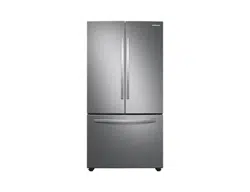Documents: Go to download!
- User Manual - (English, French, Spanish)
- Quick Guide (USA) - (English)
- Installation
- Operations
- Maintenance
- Troubleshooting
Table of contents
User manual
Installation
Refrigerator at a glance
Type A
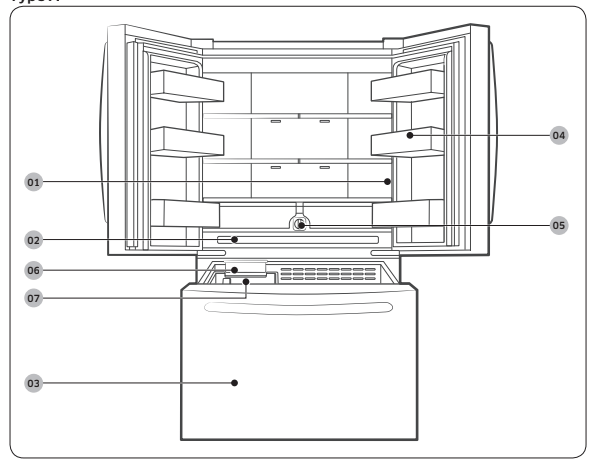
Type B

Type C
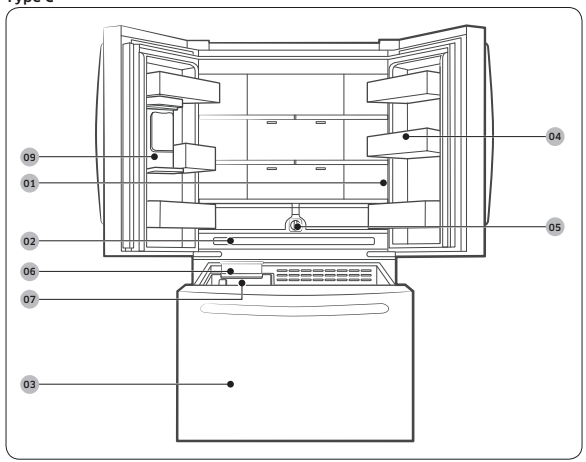
Type D


Step-by-step installation
- STEP 1 Select a site
Select a site that:
- Has a solid, level surface without carpeting or flooring that may obstruct ventilation
- Is away from direct sunlight
- Has adequate room for opening and closing the door
- Is away from any heat sources
- Provides room for maintenance and servicing
- Has a temperature range between 50 °F (10 °C) and 109 °F (43 °C)
Clearance
See the following figures and tables for space requirements for installation.
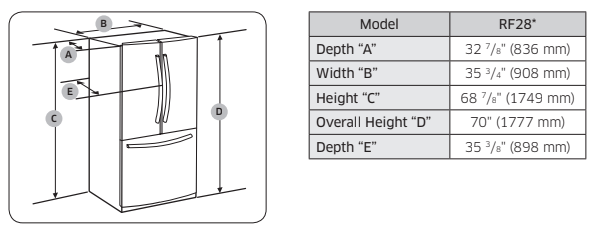
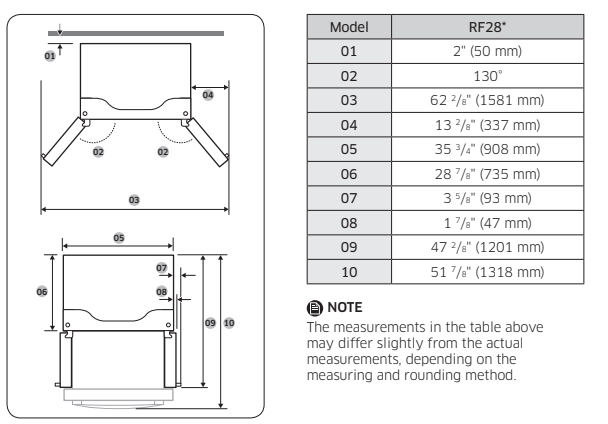
- STEP 2 Flooring
If the refrigerator cannot pass through the entrance due to its size, see STEP 3 Door
removal for entrance.
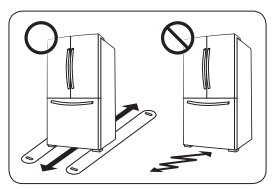
- STEP 3 Door removal for entrance
If the refrigerator cannot pass through the entrance to your home or kitchen due to its size, follow these instructions to remove and then re-install the refrigerator's doors. If you do not need to remove the doors, go to page 29 to continue the installation procedure.
Tools required (not provided)

Detach the fridge doors
- Left door
1. With the doors closed, use a Phillips head screwdriver to remove the screws (x3) in the top cover.

2. Disconnect the wires and the water tube from the left-side door. Do the following sequentially:
• Decouple the connector.
See other models: WW90T554DAX/S1 SM-T970NZKEXAR ASBH600JBECXAR WW80T684DLN/S1 SM-R180NZKAXAC
• While holding down one end of the water line coupler, disconnect the water tube.
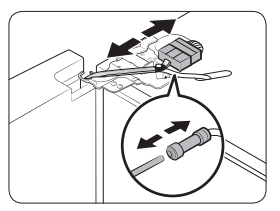
3. Gently draw up the clamp. To prevent finger injuries, do not apply a sudden force to the clamp.
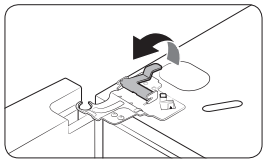
4. Pull the clamp to remove it.
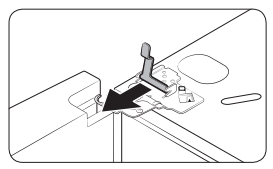
5. Open the door 90 degrees. While holding the door, pull up and remove the top hinge. Be careful not to damage the connector wires when you remove the hinge
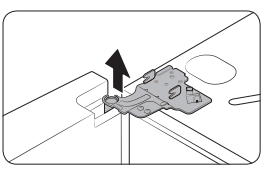
6. Gently pull up the door vertically to remove. Do not apply excessive force to the door. The door may fall, causing physical injury.
7. Lay the door down on a flat surface.
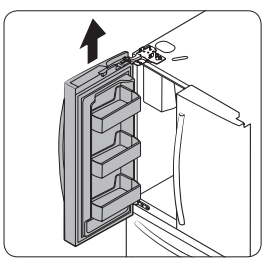
- Right door
1. Gently draw up the clamp. To prevent finger injuries, do not apply a sudden force to the clamp.
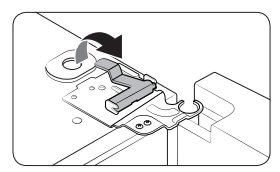
2. Pull the clamp to remove it.
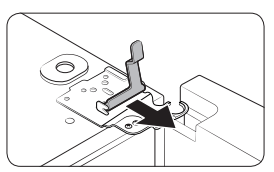
3. Open the door 90 degrees. While holding the door, pull up and remove the top hinge. Be careful not to damage the connector wires when you remove the hinge.
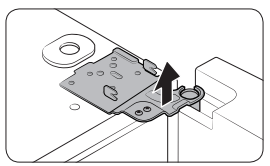
4. Gently pull up the door vertically to remove. Do not apply excessive force to the door. The door may fall, causing physical injury.
5. Lay the door down on a flat surface.
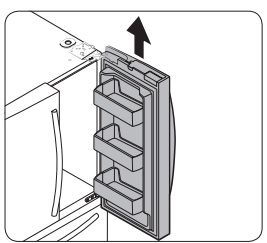
To reattach the fridge door
After you have moved the refrigerator to its final location, reattach the doors by following the removal instructions in reverse order.

To detach the freezer drawer
1. Lift up the front of the upper basket and pull to remove.
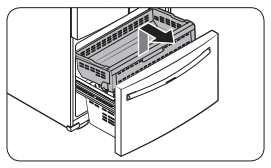
2. Then, pull up to remove the lower basket from the rail assembly.
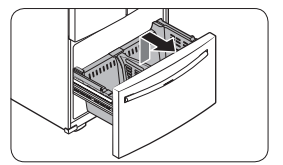
3. Press down the hooks to unlock the rail assembly.
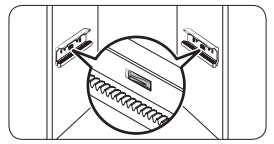
4. While holding the upper area of the freezer drawer front, slide the drawer out all the way to remove the freezer drawer from the rail assembly.
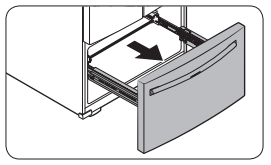
To reattach the freezer drawer
Once the refrigerator is in or near its final location, re-attach the freezer drawer by following the directions in the reverse order of removal.
- STEP 4 Leveling the refrigerator
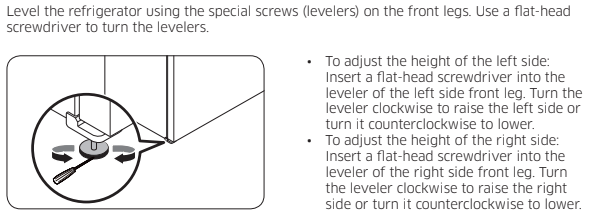
- STEP 5 Adjust the door height and the door gap
Snap rings
The height of a door can be adjusted using the provided snap rings, which come in 4 different sizes (1 mm, 1.5 mm, 2 mm, and 2.5 mm).
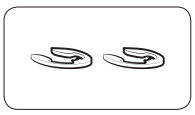
To adjust the height of a door
1. Check the height difference between the doors, and then lift up and hold the door with the lower height.
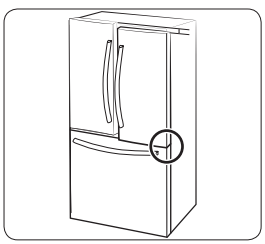
2. Insert a suitable-sized snap ring (A) between the door grommet (B) and the hinge as shown.
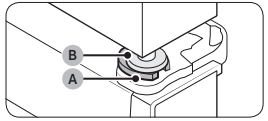
- STEP 6 Attach the handles
1. Using a Phillips screwdriver, attach the handle screws to the refrigerator, two for each handle respectively, as shown in the illustration to the left.
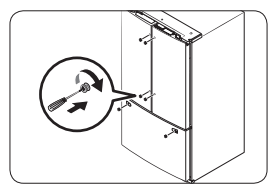
2. Attach the handle to the handle screws on the door.
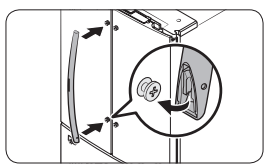
For type B handle: Insert the hook on the middle of the handle to its designated hole on the door, and then place the upper and lower part of the handles to the handle screws.
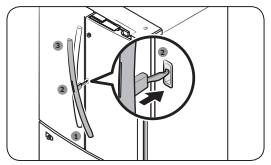
3. Push the handle down.
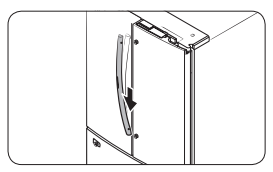
4. Insert an Allen wrench into the handle hole, and then turn it clockwise to tighten.
5. Repeat Steps 2 through 4 with the second refrigerator door handle.
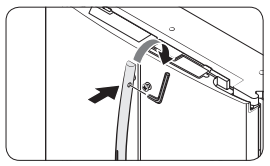
6. To attach the freezer handle to the refrigerator, first place the left side of the freezer handle onto the left handle screw, and then push it to the left.

7. Then, place the right side of the freezer handle onto the right handle screw.

8. Insert an Allen wrench into the handle hole, and then turn it clockwise to tighten.

- STEP 7 Connect the water dispenser line (applicable models only)
1. Shut off the main water source.
2. Insert the pipe clamp (B) and the shutoff valve (C) into the cold water line (A).
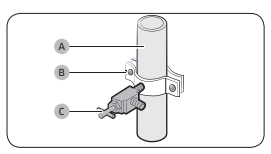
3. Connect the water line installation kit (A) to the shutoff valve (B).
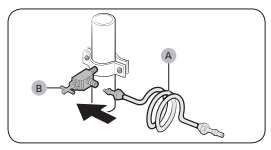
Connect the water supply line to the refrigerator
There are several items you must purchase to complete this connection. You may find these items sold as a kit at your local hardware store.


- CAUTION
Do not mount the water filter on any part of the refrigerator. This may damage the refrigerator.
1. Connect the household water line to the assembled compression fitting.
- If you are using copper tubing, slip the compression nut (07) (not supplied) and ferrule (not supplied) on the copper tubing (not supplied) as shown.
- If you are using plastic tubing (08), insert the molded end (Bulb) of the plastic tubing (08) into the compression fitting.
2. Tighten the compression nut (07) onto the compression fitting. Do not over-tighten the compression nut (07).
3. Turn the water on and check for any leakage. If you find water drops or leakage in the connection areas, turn off the main water supply. Check the connections and, if necessary, tighten.
4. Flush 1 gallon of water through the filter before drinking or using the water from the refrigerator. (Flush approximately 6 minutes.) To flush, press a large glass or cup against the water dispenser lever. Fill the glass, empty it, and then repeat.
5. After you turn on the refrigerator, let the ice maker make ice for 1 to 2 days. Over that period of time, throw out the first 1 or 2 buckets of ice the ice maker makes to ensure all impurities have been removed from the water line.
- STEP 8 Initial settings
By completing the following steps, the refrigerator should be fully functioning.
1. Plug the power cord into the wall socket to turn the refrigerator on.
2. Open the door, and check if the interior light lights up.
3. Set the temperature to the coldest setting, and wait for about an hour. Then, the freezer will be slightly chilled, and the motor should be running smoothly.
4. Wait until the refrigerator reaches the set temperature. Now the refrigerator is ready for use.
- STEP 9 Final check
When installation is complete, confirm that:
• The refrigerator is plugged into an electrical outlet and grounded properly.
• The refrigerator is installed on a flat, level surface with a reasonable clearance from walls and cabinets.
• The refrigerator is level and is sitting firmly on the floor.
• The door opens and closes freely, and the interior light turns on automatically when you open the door.
Operations
Main panel

01 Fridge / °F  °C (3 sec)
°C (3 sec)
- Fridge
- You can use the Fridge button to set the fridge temperature.
• Press Fridge repeatedly to select a desired temperature between 34 °F (1 °C) and 44 °F (7 °C).
- The temperature indicator displays the current temperature or selected temperature.
- °F
 °C
°C
- You can also use the Fridge button to switch the temperature scale between Celsius and Fahrenheit.
- To switch the temperature scale, press and hold Fridge for 3 seconds to change the current temperature scale.
02 Power Cool (3 sec) / AutoFill Pitcher
- Power Cool
- Power Cool speeds up the cooling process at maximum fan speed. This is useful to quickly cool food that spoils quickly, or after the door is left open for some time. The fridge keeps running at full speed for several hours and then returns to the previous temperature.
- Press and hold Power Cool for 3 seconds.
- Press and hold Power Cool (or AutoFill Pitcher for RF28T502*** model) for 3 seconds.
- The corresponding indicator (
 ) lights up, and the refrigerator will speed up the cooling process for you.
) lights up, and the refrigerator will speed up the cooling process for you.
- AutoFill Pitcher (RF28T502*** model only)
- If the Lock indicator (
 ) is off, press AutoFill Pitcher turn AutoFill Pitcher on. Then, open the left door of the fridge and insert the water tank. Close the door and the water tank starts to fill with water up to the preset level.
) is off, press AutoFill Pitcher turn AutoFill Pitcher on. Then, open the left door of the fridge and insert the water tank. Close the door and the water tank starts to fill with water up to the preset level. - If the Lock Indicator (
 ) is on, indicating the Lock function is active, press and hold Lock for 3 seconds to deactivate the Lock function. When the Lock indicator turns off, immediately press AutoFill Pitcher to turn AutoFill Pitcher on. Then, open the left door of the fridge and insert the water tank. Close the door and the water tank starts to fill with water up to the preset level.
) is on, indicating the Lock function is active, press and hold Lock for 3 seconds to deactivate the Lock function. When the Lock indicator turns off, immediately press AutoFill Pitcher to turn AutoFill Pitcher on. Then, open the left door of the fridge and insert the water tank. Close the door and the water tank starts to fill with water up to the preset level.
- If the Lock indicator (
03 Freezer / Power Freeze (3 sec)
- Freezer
- The Freezer button can be used to set the freezer temperature, or to activate Power Freeze. Available temperatures are between 5 °F (-15 °C) and -8 °F (-23 °C).
- Power Freeze
- Power Freeze speeds up the freezing process at maximum fan speed. The freezer keeps running at full speed for 50 hours and then returns to the previous temperature.
• To activate Power Freeze, press and hold Freezer for 3 seconds. The corresponding indicator (  ) lights up, and the refrigerator will speed up the freezing process for you.
) lights up, and the refrigerator will speed up the freezing process for you.
• To deactivate, press and hold Freezer for 3 seconds again. The freezer returns to the previous temperature setting.
• To freeze large amounts of food, activate Power Freeze for at least 20 hours before putting food in the freezer.
04 Ice Maker / Filter Reset (3 sec)
- Ice Maker
- Press Ice Maker to turn the ice maker on or off.
- The ice maker has 2 indicators (Ice Maker On / Ice Maker Off ) to indicate its operating status.
• When the ice maker operates, the corresponding indicator (Ice Maker On ) turns on.
• When the ice maker is turned off, the corresponding indicator ( Ice Maker Off) turns on. To enable ice making, you must turn the ice maker on.
- Filter Reset
- After about 6 months (and typically, about 300 gallons (1200 L) of water), the Filter indicator blinks red for several seconds when you open the door, reminding you that the filter needs to be replaced. When this happens, replace the filter, and then press and hold Ice Maker for 3 seconds. The filter lifecycle will be reset and the Filter indicator turns off.
05 Door Alarm
- Door Alarm
- If the door is left open for more than 2 minutes, an alarm will sound and the alarm indicator will blink. You can toggle the alarm on and off by pressing Door Alarm. The alarm is enabled by factory default. If the door is left open for 5 minutes, internal lights (in the fridge and freezer) will blink for 10 seconds and then turn on. The whole process will be repeated every minute for 5 minutes. This is to alert hearing-impaired users that a door is open. Note that this function is normal.
06 Lock (3 sec)
- Lock
- To prevent accidental setting changes, press and hold Lock for 3 seconds. The main panel will be disabled and the Lock indicator (
 ) will turn on.
) will turn on. - When the Lock function is on, the indicator blinks if any button on the main panel is pressed. If you press and hold the button again for more than 3 seconds, the Lock function will be deactivated. However, the Lock function will be reactivated if no button is pressed within 1 minute.
- To prevent accidental setting changes, press and hold Lock for 3 seconds. The main panel will be disabled and the Lock indicator (
07 Sabbath Mode
The Sabbath mode stays active for 85 hours once it is activated. After that, it will be deactivated automatically.
• To activate Sabbath Mode, press and hold Door Alarm and Lock simultaneously for 5 seconds. When the refrigerator is in Sabbath mode, the buttons, the display, and the internal lights do not function. The refrigerator and freezer, however, continue to cool.
• To deactivate Sabbath Mode, press and hold Door Alarm and Lock simultaneously again for 5 seconds.
08 Cooling Off
Cooling Off mode (also called Shop mode) is designed for use by retailers when they are displaying refrigerators on a retail floor.
In Cooling Off mode, the refrigerator’s fan motor and lights operate normally, but the compressors do not run so neither the refrigerator nor the freezer become cold.
To enter or exit the Cooling Off mode, press and hold Fridge and Power Cool (or Fridge and AutoFill Pitcher for RF28T502*** model) simultaneously for 6 seconds. Then, when the display blinks, press Lock.
When the Cooling Off mode is on, the refrigerator chime sounds, and the refrigerator shows “0” on the fridge temperature display and “FF” on the freezer temperature display.
Special features
Water pitcher (AutoFill Pitcher) (applicable models only)
The AutoFill Pitcher function lets you enjoy cold brewed tea in your refrigerator.
To fill the Water pitcher
1. Grasp a handle groove of the sealed mouth, and then pull up to open the lid.
2. Put tea leaves or fruit to your taste into the infuser.

3. Enable the AutoFill Pitcher function on the main panel. Open the left door of the fridge door, and then mount the water pitcher onto the holder. Push it straight in as shown in the illustration on the left.
4. Close the door. The water pitcher will start to fill with chilled water a short time later.
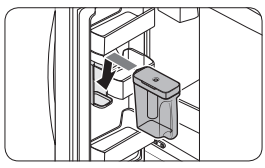
5. To drink tea, open the door and detach the water pitcher. Pull it straight out.
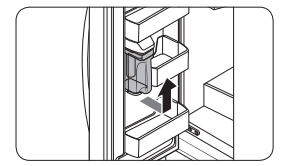
Inner dispenser (applicable models only)
To dispense chilled water, put a water glass under the dispenser, and then push the dispenser lever.
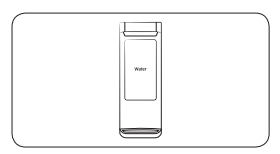
Ice maker
The refrigerator has a built-in ice maker that automatically dispenses ice so that you can enjoy filtered water with cubed or crushed ice.
Ice making
After you have installed your refrigerator and plugged it in, follow these instructions to ensure proper ice making and to keep the ice bucket full of ice:
1. Let the refrigerator operate for at least 24 hours to ensure optimal performance.
2. Dispense the first 4 to 6 ice cubes into a glass.
3. Wait another 8 hours and dispense another 4 to 6 ice cubes.
4. Then, wait another 16 hours and dispense the first glass-full of ice.
Diagnosis
If ice does not dispense, first check the ice maker.
1. Press Test on the side of the ice maker. You will hear a chime (ding-dong) when you press the button.
2. You will hear another chime if the ice maker is operating properly.
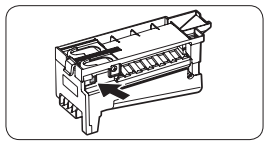
If You Turn the Ice Maker Off
If you press and hold Ice Maker for more than 3 seconds to turn the ice maker off, make sure to remove all ice cubes from the ice bucket. Remaining ice cubes may clump together, making it difficult to remove them.
Water clouding
Water supplied to the refrigerator flows through a core alkaline filter. During this filtering process, the water pressure of the water increases and the water becomes saturated with oxygen and nitrogen. This causes the water to look misty or cloudy temporarily when dispensed. This is normal and the water will look clear after a few seconds.
Maintenance
Handling and care
- Fridge shelves
The appearance of the shelves differs by model.
• To remove a shelf, fully open the corresponding door. Hold the front of the shelf, and then gently lift up and slide out.
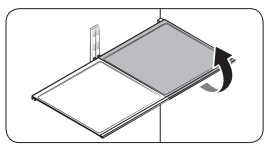
•To reinsert, hold the shelf at an angle so the front is higher than the back, and then insert the top hook into the top shelf notch. Then, lower the shelf and insert the bottom shelf hook into the bottom shelf notch.

CAUTION
• The tempered glass shelves are heavy. Use caution when removing them.
• The shelf must be inserted correctly. Do not insert upside down.
• Glass containers may scratch the surface of glass shelves.
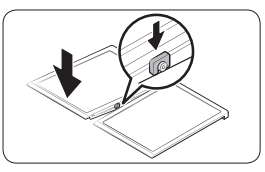
Door bins
• To remove the door bin, hold the front sides of the bin, and then gently lift up to remove.
• To reinsert, insert the door bin slightly above its final location making sure that the back of the bin is against the door. Hold the rear of the door bin with both hands, and then press down so that it fits snugly.
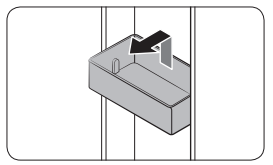
CAUTION
• Do not remove a bin that is filled with food. Empty the bin beforehand.
• Use caution when opening the door if the bottom bin contains larger bottles, which may fall over.
• Do not allow children to play with the bins. Sharp corners of the bin may cause injury.
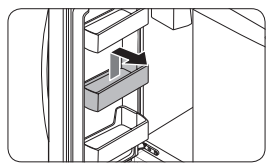
Fridge drawers
Vegetable / fruit drawers
Gently lift up the front of the drawer and slide out.
• We recommend that you remove the door bins before removing the drawer.
This is to prevent damage to the door bins.
• To reinsert, insert the drawer into the frame rails and then slide inward.

Wide Pantry (applicable models only)
• To remove, fully open the Wide Pantry. Then, slightly lift the front side and pull straight out.
• To reinsert, push the rails to the back of the refrigerator. Then, place the Wide Pantry onto the rails and slide it back until it is in place.

Freezer baskets
1. Fully open the freezer drawer.
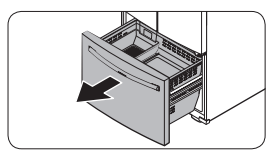
2. Lift the ice bucket to remove.

Upper basket
• To remove, fully slide open the freezer drawer. Lift up the front of the upper basket and pull to remove.
• To reinsert, align the front wheels of the upper basket with the end of the lower basket. Slide the upper basket to the front.
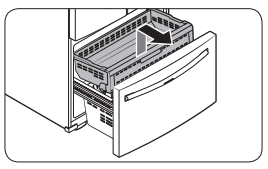
Lower basket
• To remove, first remove the upper basket. Then, tilt up the front of the lower basket to pull out.
• To reinsert, put the basket onto the rail assembly rear side first.

Cleaning
Interior and exterior
Regularly use a dry cloth to remove all foreign substances such as dust or water from the power plug terminals and contact points.
1. Unplug the power cord.
2. Use a moistened, soft, lint-free cloth or paper towel to clean the refrigerator’s interior and exterior.
3. When done, use a dry cloth or paper towel to dry well.
4. Plug in the power cord.
Rubber seals
If the rubber seals of a door become dirty, the door may not close properly and reducing refrigerator performance and efficiency. Use a mild detergent and damp cloth to clean the rubber seals. Then, dry well with a cloth.
Rear panel
To keep cords and exposed parts of the rear panel free of dirt, vacuum the panel once or twice a year.
Replacement
Water filter
The Filter Reset indicator (Filter ) turns red to let you know it is time to replace the water filter. Before replacing the filter, make sure the water supply line is shut off.
1. Shut off the water supply line.
2. Turn the knob of the filter cartridge 90 degrees counterclockwise (1/4 turn). The filter cartridge unlocks.
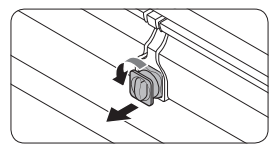
3. Pull out to remove the cartridge.
- If the water filter is severely contaminated, the cartridge may not be easy to remove. If that is the case, use force to remove the cartridge.
- To prevent water leaks from the filter opening, pull the cartridge straight out while removing it.
4. Insert a new filter cartridge. Use only Samsung-provided or approved filters.
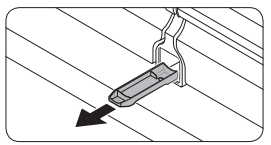
5. Turn the cartridge knob clockwise to lock into place.
6. Press and hold Ice Maker on the main panel for 3 seconds to reset the life cycle detector. The Filter Reset indicator (Filter ) turns off.

Reverse osmosis water filtration system
The water pressure of the water supply system to a reverse osmosis water filtration system must be between 30 to 120 psi (206 to 827 kPa).
The water pressure of the reverse osmosis water filtration system to the refrigerator’s cold water line must be at least 40 psi (276 kPa). If the water pressure is below these specifications:
• Check if the sediment filter in the reverse osmosis system is blocked. Replace the filter if necessary.
• Refill the water tank in the reverse osmosis system with water.
• If your refrigerator has a water filter, it may further reduce the water pressure when used in conjunction with a reverse osmosis system. Remove the water filter.
For more information or servicing, contact a licensed plumbing professional.
Ordering a new filter
To purchase a new water filter, contact a local Samsung service center or visit www. samsungparts.com on the web.
LED Lamps
To replace the lamps of the refrigerator, contact a local Samsung service center.
Troubleshooting
General
Temperature
Fridge/freezer does not operate. Fridge/freezer temperature is warm.
- Power cord is not plugged in properly.
- Properly plug in the power cord.
- Temperature control is not set correctly.
- Set the temperature lower.
- Refrigerator is located near a heat source or direct sunlight.
- Keep the refrigerator away from direct sunlight or a heat source.
- Not enough clearance between refrigerator and nearby walls or cabinets.
- Make sure there is a gap of at least 2.5 inches (5 cm) between the refrigerator back and sides and any nearby walls or cabinets.
- The refrigerator is overloaded. Food is blocking the refrigerator vents.
- Do not overload the refrigerator. Do not allow food to block vents.
Fridge/freezer is over-cooling.
- Temperature control is not set correctly.
- Set the temperature higher.
Interior wall is hot.
- Refrigerator has heat-proof piping in the interior wall.
- To prevent condensation from forming, the refrigerator has heat-proof piping in the front corners. If the ambient temperature rises, this equipment may not work effectively. This is not a system failure.
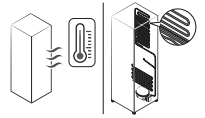
Odors
Refrigerator has odors.
- Spoiled food.
- Clean the refrigerator and remove any spoiled food.
- Food with strong odors.
- Make sure strong smelling food is wrapped airtight.
Frost
Frost around the vents.
- Food is blocking the vents.
- Make sure no food blocks the refrigerator vents
- Door is not closed properly.
- Make sure food does not block the door. Clean the door gasket.
Condensation
Condensation forms on the interior walls.
- If door is left open, moisture enters the refrigerator.
- Remove the moisture and do not leave a door open for extended periods of time.
- Food with high moisture content.
- Make sure food is wrapped airtight.
Water/ice (dispenser models only)
Water flow is weaker than normal.
- Water pressure is too low.
- Make sure the water pressure is between 30 to 120 psi (206 to 827 kPa).
Ice maker makes a buzzing sound.
- The Ice Maker function is activated, but the water supply to the refrigerator has not been connected.
- Press Ice Maker.
Ice maker does not make ice.
- Ice maker has just been installed.
- You must wait for 12 hoursfor the refrigerator to make ice.
- Freezer temperature is too high.
- Set the freezer temperature below 0 °F (-18 °C) or -4 °F (-20 °C) in warm ambient air.
- Dispenser panel Lock is activated.
- Deactivate dispenser panelLock.
- Ice maker is off.
- Turn on the ice maker.
Ice does not dispense.
- Ice may jam if the ice dispenser is not used for a long time (approx. 3 weeks).
- If you won't be using the refrigerator for a long time, empty the ice bucket and turn off the ice maker.
- Ice bucket is not properly inserted.
- Make sure the ice bucket is properly inserted.
- Water line is not connected properly or water supply is not on.
- Check if the water line is installed correctly. Check if the water line stop cock is closed.
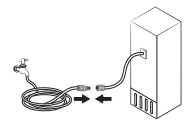
Water does not dispense.
- Water line is not connected properly or water supply is not on.
- Check if the water line is installed correctly. Check if the water line stop cock is closed.
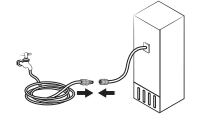
- Dispenser panel Lock is activated.
- Deactivate dispenser panel Lock.
- A third-party water filter was installed.
- Use only Samsung-provided or approved filters.
- Unapproved filters may leak and damage the refrigerator.
- Water filter indicator turns on or blinks.
- Replace the water filter. After replacing, reset the filter indicator sensor.
Do you hear abnormal sounds from the refrigerator?
These sounds are normal.
• When starting or ending an operation, the refrigerator may make sounds similar to a car engine ignition. As the operation stabilizes, the sounds will decrease.

• While the fan is operating, these sounds may occur. When the refrigerator reaches the set temperature, the fan sound will stop.

• During a defrost cycle, water may drip on the defrost heater, causing sizzling sounds.

• As the refrigerator cools or freezes, refrigerant gas moves through sealed pipes, causing bubbling sounds.

• As the refrigerator temperature increases or decreases, plastic parts contract and expand, creating knocking noises. These noises occur during the defrosting cycle or when electronic parts are working.

• For ice maker models: When the water valve opens to fill the ice maker, you may hear a buzzing sound.
• Due to pressure equalizing when you open and close the refrigerator door, you may hear a whooshing sound.
